Overview
This article delves into compassionate strategies for managing behavior challenges associated with autism. It highlights the importance of:
- Establishing routines
- Implementing positive reinforcement
- Teaching coping skills
These approaches resonate deeply with parents seeking effective solutions. Supported by research and practical examples, these strategies demonstrate their effectiveness in enhancing emotional regulation and behavior in children with autism.
It's crucial to recognize the roles of:
- Consistency
- Choice-making
- Professional support
in fostering positive outcomes. As you explore these techniques, consider how they might fit into your own experiences and journey. Your insights and stories are valuable, and sharing them can create a supportive community for others facing similar challenges.
Introduction
In a world where our understanding of autism spectrum disorder (ASD) is rapidly evolving, the challenges associated with autism behavior problems continue to weigh heavily on many families. As the demand for effective behavior management strategies grows, so does the need for accessible resources and community support. This article explores nine proven strategies designed to empower caregivers and enhance the well-being of children with autism.
How might these techniques transform the daily lives of families navigating the complexities of autism? Join us as we delve into insights and actionable approaches that promise to make a meaningful difference.
About ASD Media: Comprehensive Resources for Autism Behavior Management
At ASD Media, we are deeply committed to enhancing the execution of Applied Behavior Analysis (ABA) therapy. Our goal is to provide a comprehensive range of resources designed to effectively address the challenges associated with autism behavior problems. We understand that parents and professionals alike need valuable insights, strategies, and community support to navigate these complexities. By fostering a collaborative environment, we enable individuals to share their experiences and learn from one another, which is vital for improving outcomes for youth with ADHD.
Recent trends reveal a significant increase in the demand for certified ABA therapists, with an astonishing 5,852% rise from 2010 to 2021. This statistic highlights a growing recognition of the importance of community support models in tackling developmental disorder challenges. However, it is concerning that nearly 30% of U.S. youth with autism behavior problems and other developmental disorders do not receive any behavioral or medication treatment. This gap underscores the urgent need for accessible resources and support systems.
At ASD Media, we strive to bridge this gap by advocating for effective behavior management techniques to address autism behavior problems. Our initiatives aim to create meaningful improvements in the lives of those affected by these conditions. We invite you to join our community, share your experiences, and explore the resources available to help make a difference. Together, we can enhance the lives of youth with developmental disorders and foster a brighter future.
Establish a Predictable Routine: Creating Stability for Autistic Children
Creating a reliable schedule is essential for individuals with autism. Establishing regular times for daily tasks such as meals, play, and bedtime can significantly enhance their well-being. Visual schedules serve as powerful tools in this journey, providing young individuals with a clear view of what comes next, which can greatly alleviate the anxiety often associated with transitions. Research indicates that visual schedules not only improve communication and comprehension but also foster a sense of security and reassurance in youth.
For instance, one study highlighted that children in the experimental group showed remarkable improvement in self-care activities, with mean scores rising from 25.56 to 40.43 after the intervention. By fostering a structured environment, parents can support emotional regulation and mitigate autism behavior problems, leading to a more harmonious daily experience for the entire family.
Successful implementations of visual schedules, such as those seen in the Miller family, illustrate that young individuals can manage their daily activities with greater independence, thereby strengthening their ability to navigate routines effectively. Additionally, these schedules can be customized to reflect personal preferences, ensuring they are flexible enough to meet the unique needs of each young learner.
To maximize the effectiveness of visual schedules, it is beneficial for parents to regularly review and adjust them to accommodate any changes in their child's routine. This ongoing support not only helps children feel more secure but also empowers them to thrive in their daily lives.
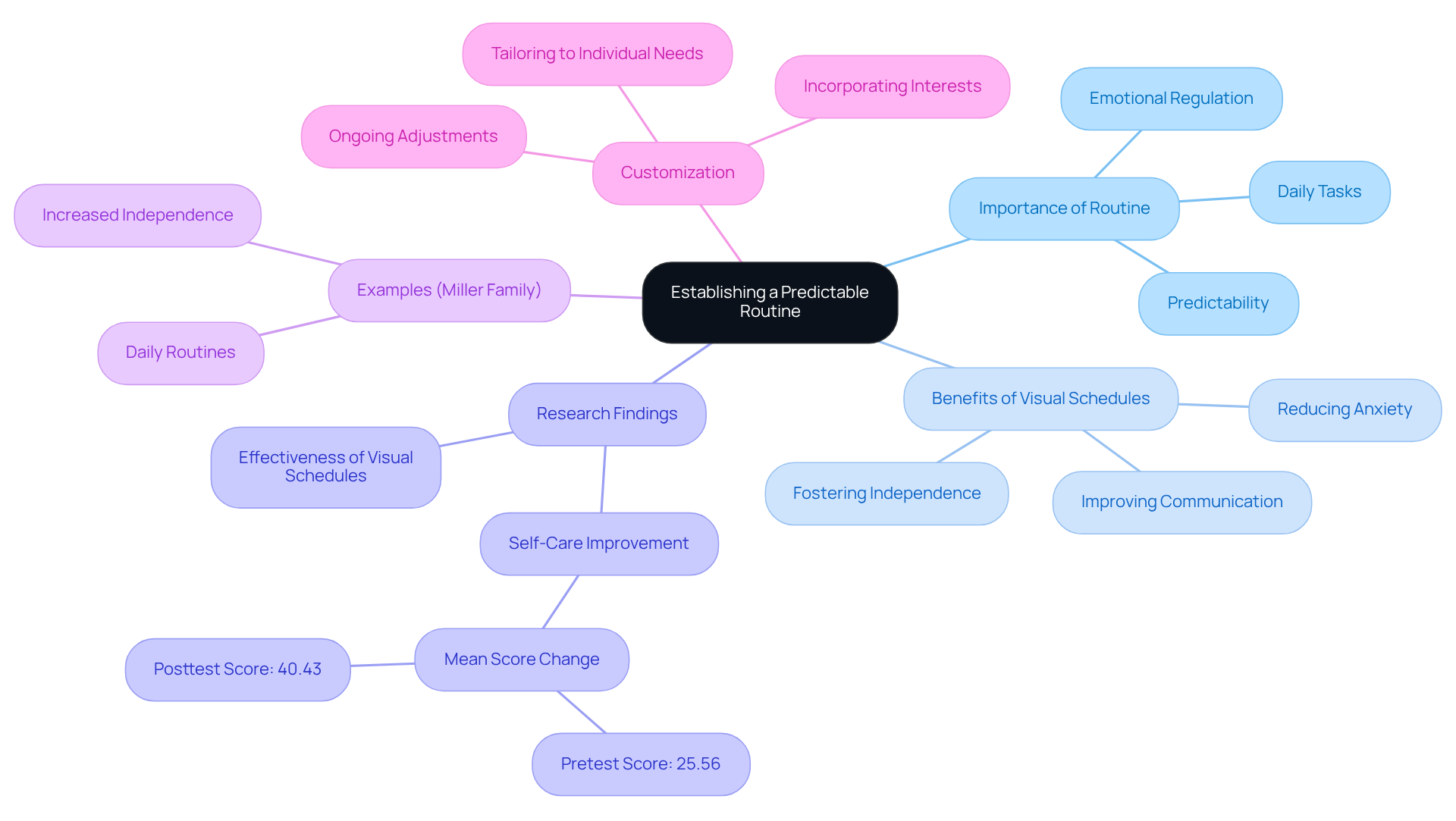
Implement Positive Reinforcement: Encouraging Desired Behaviors in Autism
Positive reinforcement serves as a nurturing approach to encourage preferred actions in children with autism, rewarding them for their achievements. This can manifest in various forms, such as heartfelt verbal praise, tangible rewards like stickers or toys, and special privileges. For instance, when a child successfully completes a task independently, acknowledging their effort with praise or a small reward can significantly motivate them to repeat that behavior. Research suggests that effective rewards include edible treats, toys, and enjoyable activities tailored to each child’s interests, enhancing their engagement and participation in therapy.
Consistency in applying positive reinforcement is essential for its effectiveness. It helps children grasp the connection between their actions and the rewards they receive, fostering a sense of trust and clear expectations. Studies indicate that prompt reinforcement following preferred actions strengthens this connection, leading to lasting improvements in behavior. Furthermore, the effective use of positive reinforcement has been documented across various environments, highlighting its role in managing autism behavior problems and promoting positive developmental outcomes. As behavior analysts emphasize, a well-structured reinforcement strategy can lead to significant advancements in communication skills, patience, and social interactions for individuals on the autism spectrum.
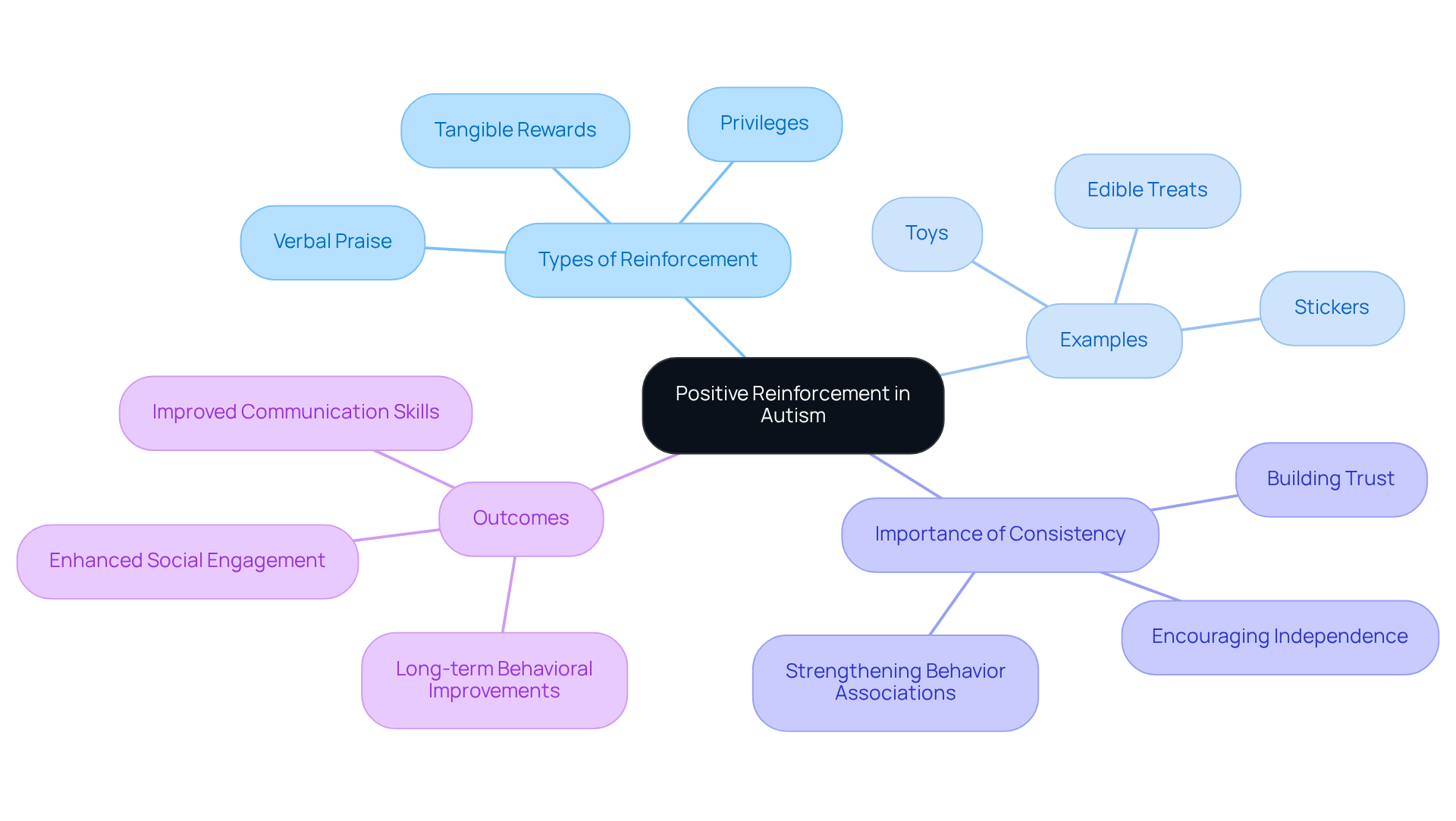
Teach Coping Skills: Equipping Children to Handle Challenges
Coping abilities are essential for youth with autism behavior problems as they navigate intense emotions and face various challenges. Techniques such as:
- Deep breathing
- Counting to ten
- Using sensory tools
can greatly support emotional regulation. By introducing these skills during calm moments, young individuals can practice them before stressful situations arise, ultimately strengthening their ability to cope when it matters most.
Research shows that deep breathing exercises enhance relaxation and reduce anxiety, while sensory tools offer comfort and assist with self-regulation. By consistently reinforcing these strategies, caregivers can empower their children to improve their behavior and address autism behavior problems, as well as enhance their emotional well-being. This nurturing approach fosters resilience, equipping them to handle challenges with greater confidence.
As you explore these techniques, consider sharing your experiences or thoughts in the comments. Together, we can build a supportive community that uplifts our children and helps them thrive.
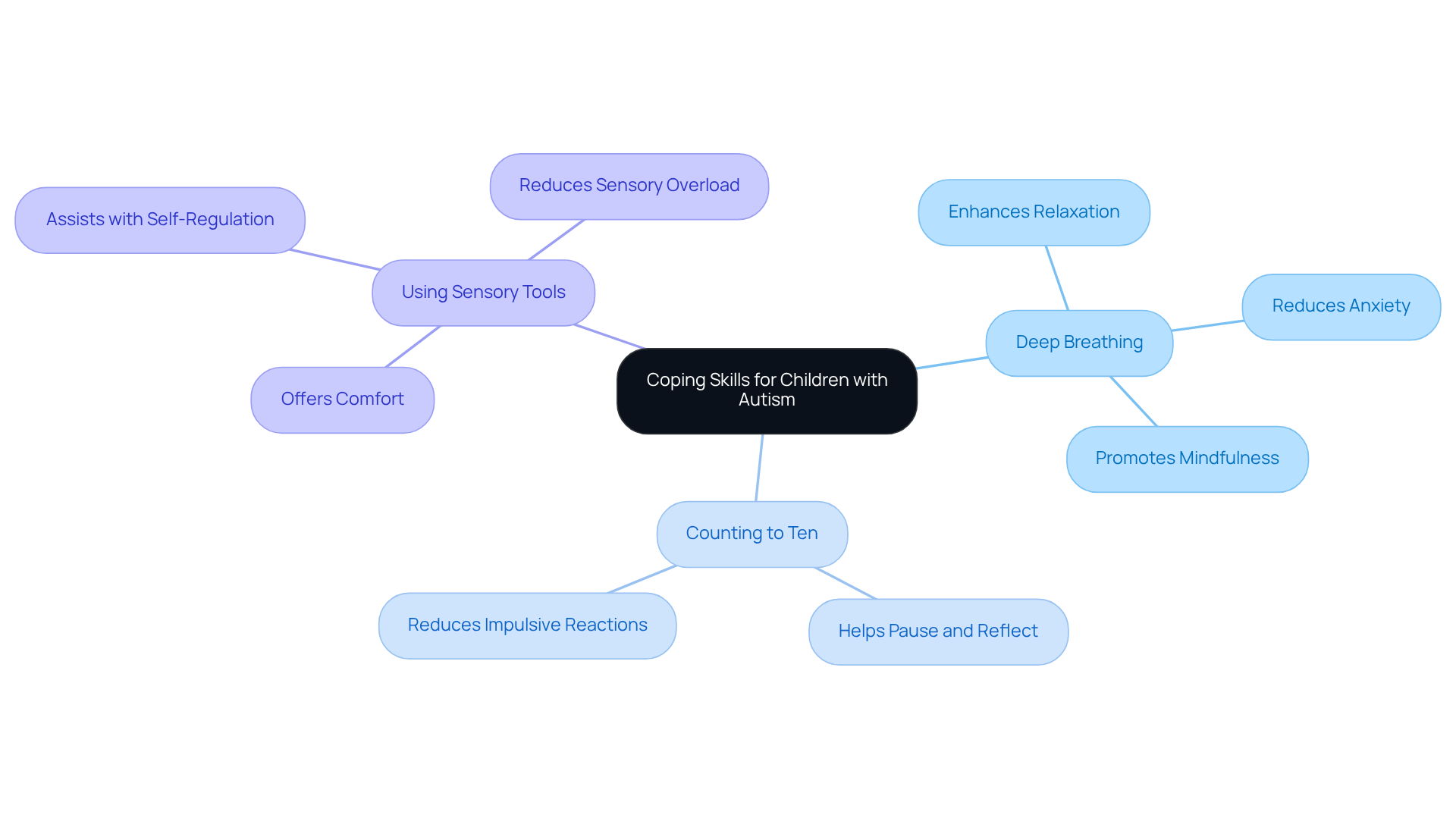
Identify Behavior Triggers: Understanding the Roots of Challenging Actions
Recognizing the triggers of autism behavior problems is crucial for effective management. Imagine being a caregiver, navigating the complexities of behavior—maintaining a conduct journal can be an invaluable resource. This tool allows caregivers to record when and where particular actions occur, along with the surrounding context. By doing so, they can identify common triggers such as:
- Sensory overload
- Changes in routine
- Specific social situations
Research highlights the positive impact of activity journals, revealing that 70% of guardians reported a better understanding of their children's actions after keeping one. This insight can be transformative. By understanding these underlying factors, including potential internal triggers like food allergies or emotional issues, caregivers can better support their children's emotional regulation and address autism behavior problems, fostering a more nurturing environment for positive behavior.
To begin this journey, parents should note specific instances of autism behavior problems, the context surrounding them, and any internal or external factors that may have contributed. This practice not only aids in understanding but also empowers caregivers to create supportive strategies tailored to their children's unique needs.
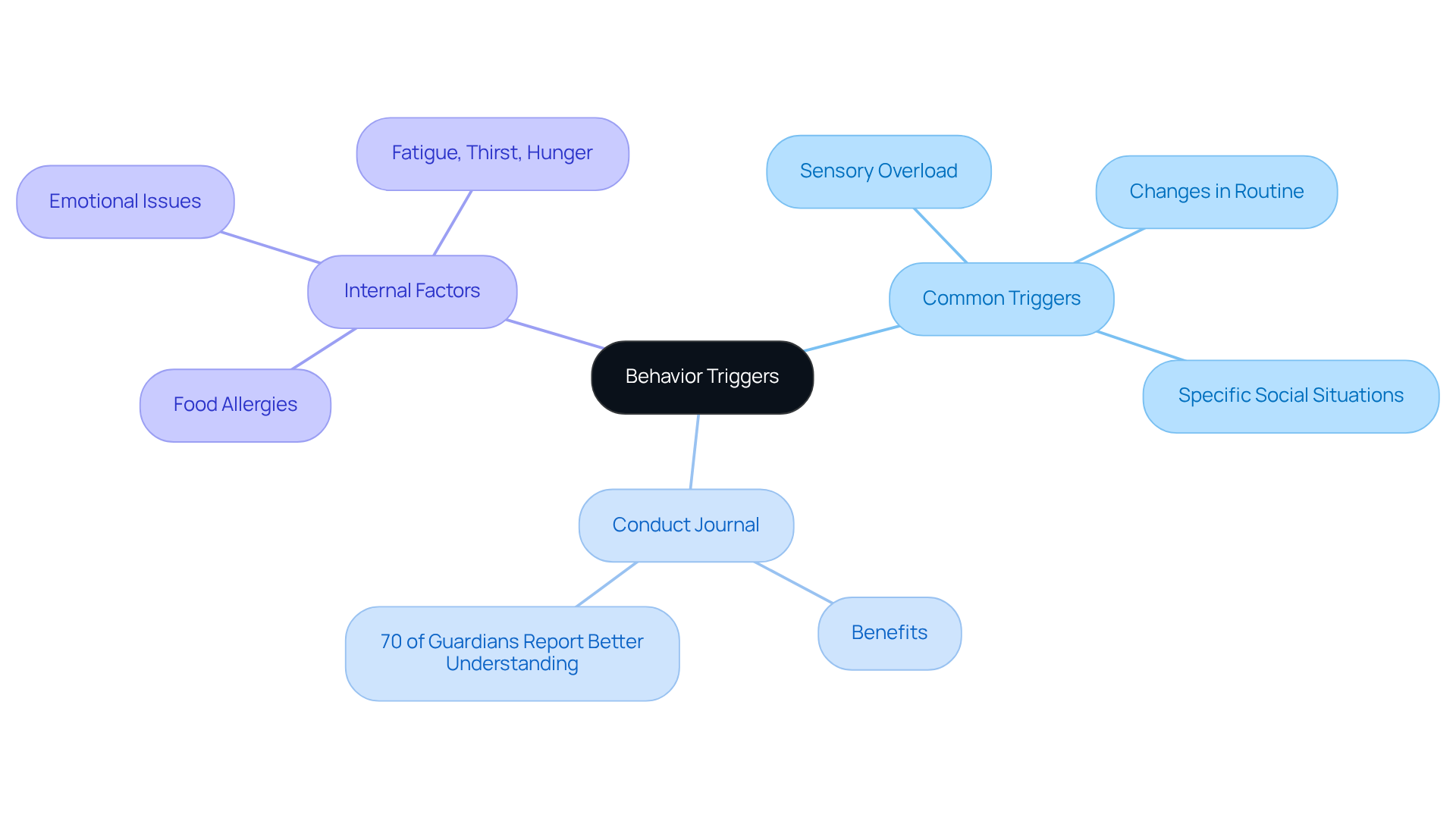
Maintain Consistency: Reinforcing Behavioral Expectations
Consistency in behavioral expectations is crucial for individuals with autism. It involves applying the same rules and responses across different settings, creating a sense of security. For instance, if a child is encouraged to use polite language at home, this expectation should also be reinforced in school and social environments. Such uniformity clarifies what is expected, alleviating anxiety that often arises from differing standards related to autism behavior problems. Research indicates that when behavioral expectations are consistent between home and school, young individuals experiencing autism behavior problems demonstrate enhanced comprehension and adherence, leading to better emotional regulation and social interactions.
Parents can play a pivotal role in this journey by collaborating with teachers and caregivers to ensure these expectations are consistently upheld. Regular communication between parents and teachers is a successful strategy where insights and effective approaches are shared. For example, one family established a weekly meeting with their child's teacher to discuss behavioral progress and reinforce strategies that promote consistency. This proactive approach not only strengthens the child's understanding of expectations but also builds a supportive network that nurtures their overall development.
By consistently reinforcing behavioral expectations, parents and teachers can create a stable environment that fosters the individual's growth, helping them navigate social situations with greater ease. Together, let’s create a community of support that empowers our children to thrive.
Offer Choices: Empowering Autistic Children in Decision-Making
Empowering individuals with autism through choice-making can be as simple as allowing them to select between two snacks or choose an activity for the day. This practice nurtures a sense of control, encouraging young individuals to express their preferences and interests. Research indicates that integrating decision-making opportunities into daily activities significantly enhances engagement and motivation, leading to more positive interactions and actions.
For example, structured decision-making opportunities, such as choosing outfits or meals, not only bolster self-advocacy but also contribute to emotional well-being. As Sarah Helm wisely notes, 'A good rule of thumb is to provide choice where possible and provide guidance where it is not.'
By consistently offering options, parents can create an environment that fosters autonomy and reduces autism behavior problems, ultimately improving the quality of life for their children. Moreover, studies reveal that participants displayed higher levels of on-task engagement during choice conditions compared to baseline, reinforcing the idea that choice-making is a powerful tool in managing autism behavior problems.
Teach Boundaries: Helping Children Understand 'No'
Teaching children about boundaries is essential for their development and requires clear communication about what constitutes acceptable and unacceptable behavior. Concepts like 'good touch' and 'bad touch' can be made more relatable through the use of visual aids such as PECS cards and hula hoops. Role-playing activities and consistent reinforcement can significantly enhance their understanding of the word 'no' and the importance of personal space. For instance, demonstrating that interrupting someone while they are speaking is inappropriate helps children grasp social cues, fostering respect in interpersonal interactions.
Engaging activities, like role-playing scenarios, provide a safe environment for children to practice these skills, reinforcing their ability to navigate social situations effectively. Research shows that incorporating visual supports can improve retention rates by up to 400%, making the lessons about personal boundaries even more impactful. It is also vital to approach the teaching of personal space with cultural sensitivity, as norms can vary across different backgrounds.
By consistently applying these strategies, parents can empower their children to recognize and respect personal space. This not only enhances their social skills but also boosts their confidence in various interactions. Remember, your involvement in these discussions is crucial—take the time to engage with your children about their experiences and feelings regarding personal boundaries. Together, you can create a nurturing environment that fosters their growth and understanding.
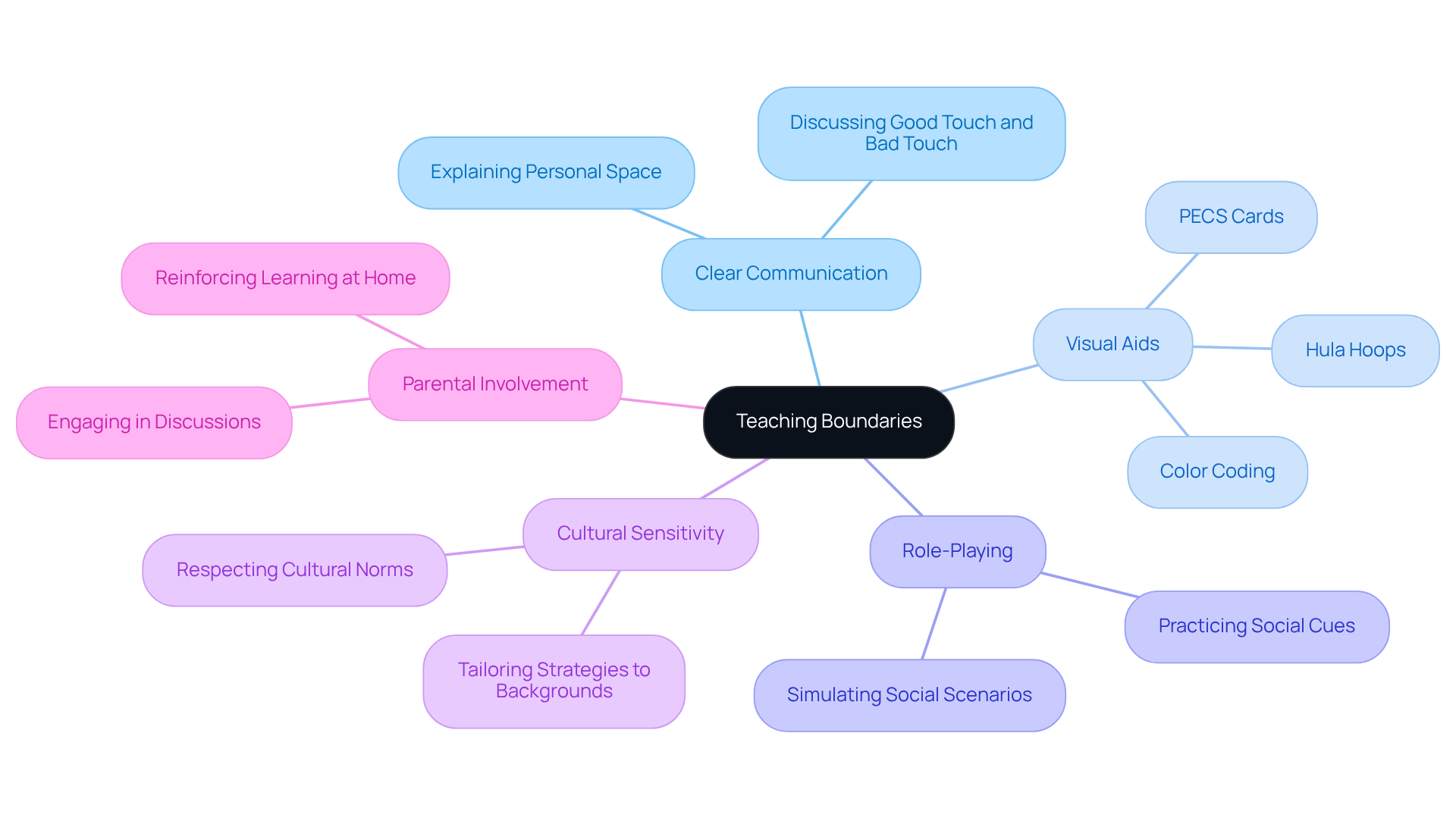
Seek Professional Support: Collaborating with Experts for Effective Management
Engaging with experts such as ABA therapists, psychologists, or special educators can be a game-changer for families navigating the challenges of autism. These compassionate specialists are equipped to:
- Conduct thorough evaluations
- Develop personalized action plans
- Offer guidance tailored specifically for guardians and caregivers
By collaborating with these knowledgeable professionals, families can ensure they are utilizing evidence-based strategies that align with their child's unique needs. This partnership not only fosters a deeper understanding but also leads to a more effective approach in managing behaviors, ultimately nurturing a supportive environment for growth and development.
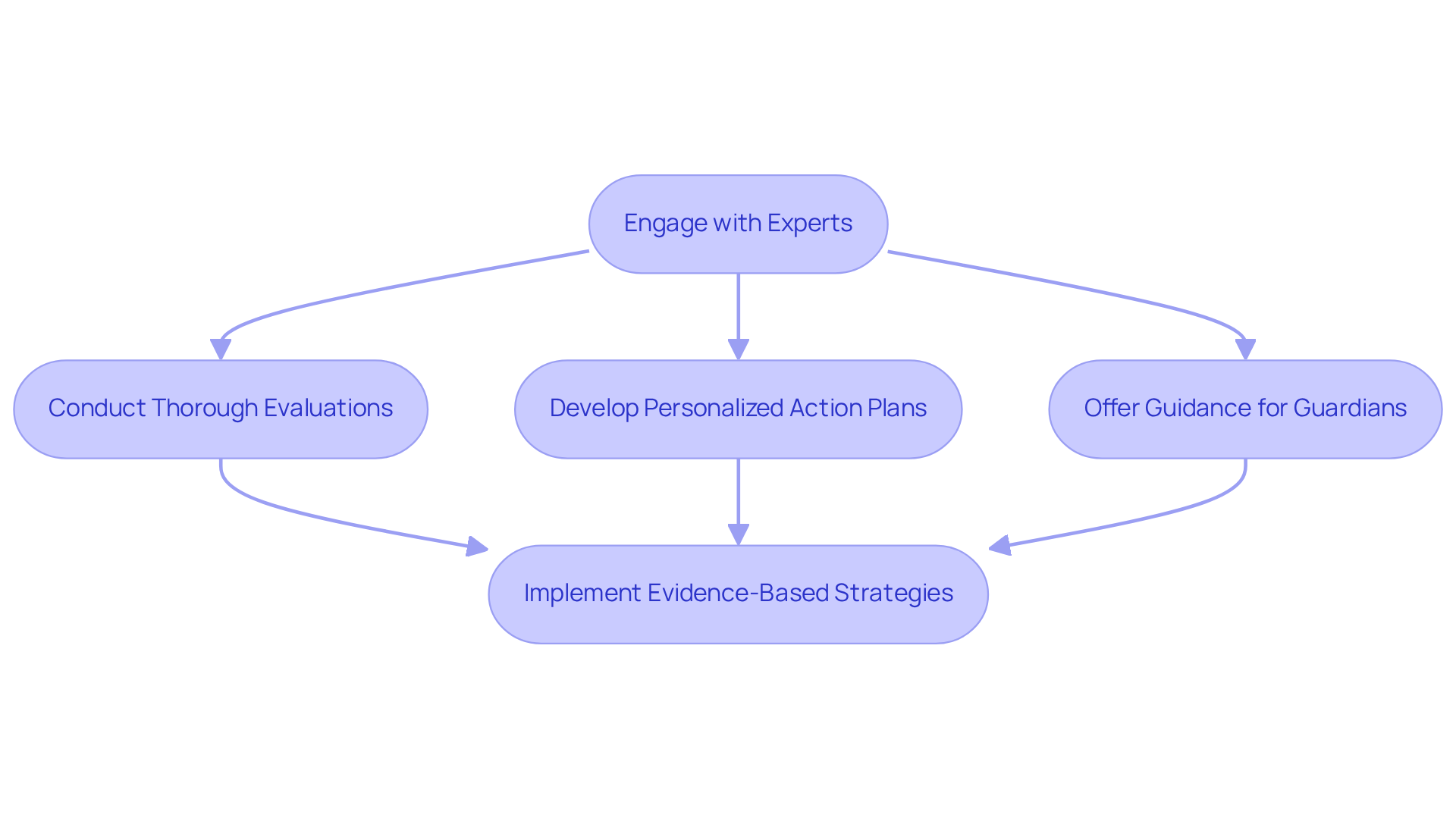
Involve Parents: Strengthening Home Support for Behavior Management
Involving guardians in the conduct management process is not just beneficial; it's essential for nurturing skills and strategies at home. Imagine attending therapy sessions together, participating in training, and consistently implementing behavior plans—this involvement can take many forms. When guardians and professionals communicate openly, it cultivates a supportive atmosphere that significantly enhances the individual's learning and development.
Additionally, caregiver support groups emerge as invaluable resources. They provide motivation and collective experiences that help families navigate the challenges of the condition together. Research shows that these groups can boost parenting confidence and alleviate stress, ultimately leading to improved outcomes for children with autism. By connecting with others facing similar challenges, parents can gain insights and strategies that empower them on their journey.
So, if you’re a guardian, consider reaching out to these support networks. You’re not alone in this; there are communities ready to embrace you and share their experiences. Together, we can create a nurturing environment that fosters growth and understanding.
Conclusion
In the journey of managing autism behavior problems, it is essential to recognize the importance of employing a variety of effective strategies that empower both caregivers and children. By integrating these techniques, families can cultivate a more supportive and nurturing environment that enhances the well-being of youth with autism.
The nine strategies discussed—ranging from establishing predictable routines and implementing positive reinforcement to teaching coping skills and identifying behavior triggers—highlight the multifaceted approach required for effective autism behavior management. Each technique offers valuable insights into fostering emotional regulation, enhancing communication, and building resilience among children. The significance of consistency in behavioral expectations and the empowerment through choice further underscore the need for a tailored approach that meets the unique needs of each child.
Ultimately, the call to action is clear: engaging with professionals, involving parents, and utilizing community resources can significantly improve outcomes for children with autism. By fostering collaboration and sharing experiences, families can navigate the complexities of autism together, ensuring that every child has the opportunity to thrive. Embracing these strategies not only enhances individual development but also cultivates a more inclusive and understanding society for all.
Frequently Asked Questions
What is ASD Media and its mission?
ASD Media is dedicated to enhancing the execution of Applied Behavior Analysis (ABA) therapy by providing a comprehensive range of resources aimed at addressing challenges associated with autism behavior problems. They focus on offering insights, strategies, and community support for parents and professionals.
What recent trend has been observed regarding the demand for ABA therapists?
There has been a significant increase in the demand for certified ABA therapists, with a remarkable 5,852% rise from 2010 to 2021, indicating a growing recognition of the importance of community support models in addressing developmental disorder challenges.
What percentage of U.S. youth with autism behavior problems do not receive treatment?
Nearly 30% of U.S. youth with autism behavior problems and other developmental disorders do not receive any behavioral or medication treatment, highlighting the urgent need for accessible resources and support systems.
How can establishing a predictable routine benefit autistic children?
Creating a reliable schedule for daily tasks can significantly enhance the well-being of individuals with autism. Regular routines help alleviate anxiety associated with transitions and foster emotional regulation.
What are visual schedules and how do they help autistic children?
Visual schedules provide a clear view of upcoming tasks, which can improve communication and comprehension while fostering a sense of security. They have been shown to enhance self-care activities and help children manage their daily routines with greater independence.
How should parents implement and adjust visual schedules?
Parents should regularly review and adjust visual schedules to accommodate changes in their child's routine. This ongoing support helps children feel more secure and empowers them to thrive in their daily lives.
What is positive reinforcement and how is it used with children with autism?
Positive reinforcement is a nurturing approach that encourages preferred actions by rewarding children for their achievements. Rewards can include verbal praise, tangible items like stickers or toys, and special privileges.
Why is consistency important in applying positive reinforcement?
Consistency helps children understand the connection between their actions and the rewards they receive, fostering trust and clear expectations. Prompt reinforcement following preferred actions strengthens this connection, leading to lasting improvements in behavior.
What are the benefits of using positive reinforcement in managing autism behavior problems?
Effective use of positive reinforcement can lead to significant advancements in communication skills, patience, and social interactions for individuals on the autism spectrum, promoting positive developmental outcomes.




